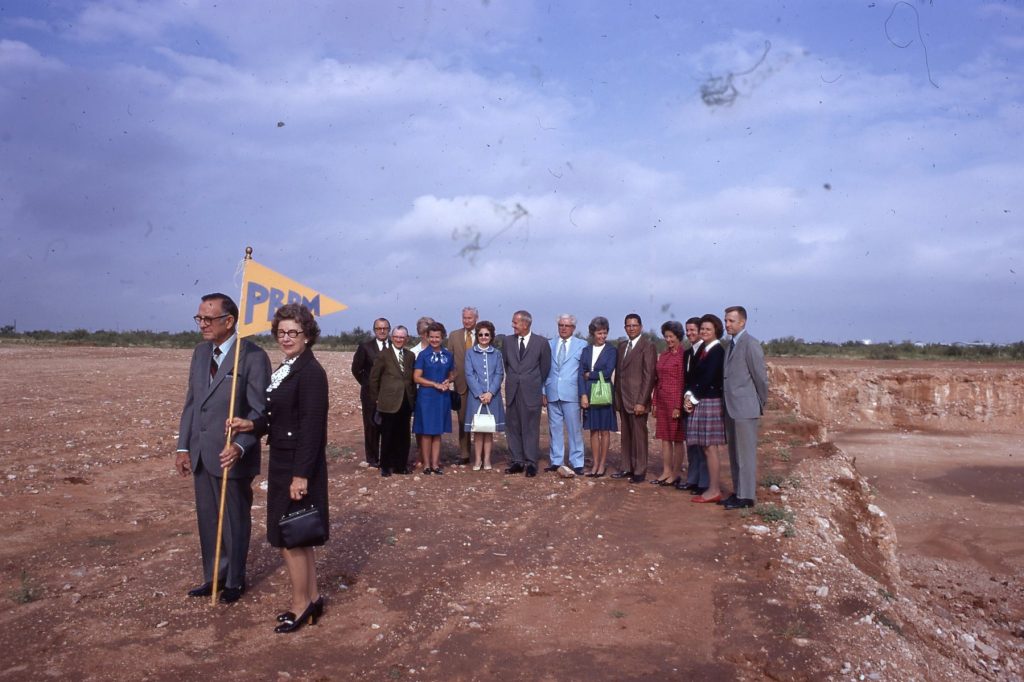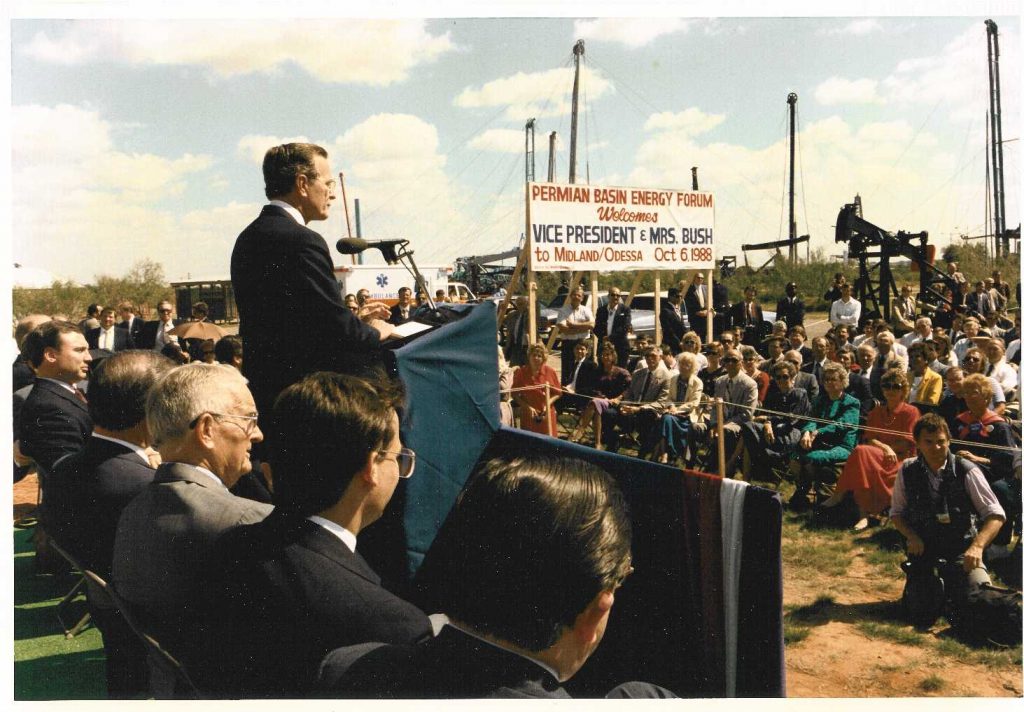Click here to listen to the Audio verison of this story!

George and Gladys Abell at the groundbreaking for the Permian Basin Petroleum Museum. the Abells were pivotal figures in the founding of the museum.
MIDLAND, TEXAS—A lot of different words could be used to describe the Permian Basin Petroleum Museum, but here is one that will ring true for many, especially for the young: magical.
The Petroleum Museum is a magical place. Surrounded by its wondrous collections and displays, indoors and out, visitors can lose themselves in beauty, wonder, marvels, and the spirit of innovation. In my own visits there, I have felt those qualities, and I have absorbed more knowledge, and gained more understanding, and done so faster, than perhaps I have during comparable hours spent anywhere else in our oil and gas world.
Visitors do not have to be an oil and gas devotee to find themselves mesmerized by their experiences here. Consider the Petroleum Exhibits alone: 15,000 square feet of interactive exhibits covering all aspects of the petroleum industry. From inter-actives to immersive environments to game-based learning experiences, this space entertains guests of all ages.
It is just a magical circumstance that an institution like this exists to tell oil’s story to the world, to dispel the untruths hurled at oil and gas, to provide a look inside a vital, meaningful industry. There is something magical in the fact that the Permian Basin Petroleum Museum simply is. And in the fact that people pooled the resources and make the sacrifices to bring this place into existence.
With this month marking the 50th Anniversary of the museum, we take a moment to celebrate its worth.
I met with staff at the Petroleum Museum recently to catch up on the latest. Sitting in their offices, I heard mostly from Director of Development Luanne Thornton, but Director of Community Development Mara Bland and other team members gave input as well.
Luanne said that the Petroleum Museum is “all about education.”
“Whether it’s a child visiting here, or whether it’s an adult who has pulled in off the interstate [the museum sits right on I-20] and knows nothing about the industry, they get an education here,” she said.
Someone else added: “Or people who THINK they know a lot about the industry and have the complete wrong idea and come in and go…. Oh!” [laughter]. “Those people get an education, too!”
“Absolutely!” Luanne said. “We see around 40,000 to 45,000 visitors a year, and that includes children, school tours, and all those people off the interstate who are stopping by.”
There have been many changes in 50 years, but the education dimension has been a constant.
I learned that when the museum opened in 1975, its exhibits were mainly historical and technological. The displays were meant to show the progress of the Permian Basin oil and gas industry (and to some extent the broader oil and gas industry) from its inception until the then-present time. But the museum’s staff and leadership realized, over time, that something more was needed. That “something more” arrived over the ensuing decades, and emerged via an evolution of the museum’s direction and mission. Increasingly, truth telling and education took their place alongside the historical narrative.
And advocacy became a factor, too. “We came to realize we’re the advocate for the industry,” Luanne said. “We needed to be focused on that as well—to represent the industry to those who don’t understand it.”
In the early 1980s, a north wing was added—displaying mainly heavier technology. The year 1996 brought with it the arrival of the rotary rig that now towers beside Interstate 20 on the west side of the grounds. Meanwhile, the museum’s Oil Patch—its 40-acres of outdoor exhibits of vintage machinery—kept growing.
The Chaparrals Gallery (race cars) was added indoors in an expansion in 2004. The dazzling Minerals Gallery opened in December 2012 to showcase nature’s most beautiful wonders. In 2016 came a news-making $18 million renovation to the institution.
“Nobody else is telling this story like we are,” Luanne said. “When we did that major renovation, we made sure to weave the economics of the industry through all of it—because no one understands it. People really do think the guy working at Seven-Eleven decides the price of oil today.” [laughter]

Vice President George H.W. Bush spoke on the museum premises during the Permian Basin Energy Forum in October, 1988.
Staff members say it’s not uncommon to be in a gallery of the museum and hear people conversing in foreign tongues. “You’ll get to talking with someone and they’ll say, “I’m here on vacation from Sweden—or New Zealand—or Germany,” someone said. “I’ve been shocked the past few years by how many people we affect globally. We get journalists from foreign countries coming here to gain understanding about this industry.”
Luanne said, “Reporters are coming out here because we have more oil than Saudi Arabia, and they are figuring that out. I’m sure they Google their questions and find us, and we’re a resource. And as we are a museum, we’re committed to truth telling, so they [reporters] feel confident in reaching out to us. They know they’re going to get fact-based, honest answers.
Television reporters also come to the museum because they can get backdrops and interior/exterior shots and B-roll footage and other film/video needs, all in one stop.
This place has roughly tripled in size since it was founded. The most recent major development (2023) at the museum was the creation of its STEAM Education Center. The emphasis on STEAM [Science, Technology, Engineering, Arts, and Math] reflects the museum’s expanding mission to educate.
Said Luanne: “If we can get these children excited today about science and seeing that it’s fun—whether it’s a boy or a girl you’re talking about—who knows what our future can be? Girls tend to fall off [from the STEM disciplines] in junior high and high school. But if they can see that this is fun, there’s no telling where the next generation will take us.”
In the week I visited, the STEAM Center had hosted 80 (!) six- to eight-year-olds for hands-on experiments and learning sessions. But the museum also does adult sessions as well. And with their auditorium, the museum often hosts training sessions for oil and gas companies. On the day I was there, ExxonMobil was conducting such a session, and one parking lot was packed with white pickups—maybe close to 100 of them.
Every month, special events beckon visitors and locals. There are Family Science Nights. And “brown bag lunch and lectures” that feature prominent spokespeople, for instance. “We’ve had Alex Epstein,” Luanne observed. “Harrison Schmitt, a former astronaut, U.S. Senator, and geologist, spoke at one.” Schmitt, incidentally, was the last human to walk on the moon.
We toured the STEAM center and it was huge. And awesome. Said Luanne: “Only seven million dollars.” [laughter] She added: “We’ve also expanded into offering live, virtual classes to people across the nation. They can sign up for geology. There’s a robotics class. And more.”
And it’s all devoted to serving this industry and this community and making lives better—the same thing that oil and gas does.
For a last word on this anniversary milestone, let’s turn to oilman D. Kirk Edwards, who happens to be a big fan of this institution.
“The Petroleum Museum has always been my first recommendation to anyone from out of town who wants to be introduced to the real oil industry and its incredible history,” Edwards said. “You can’t find their quality of work and exhibits anywhere else in the world. What a jewel we have here in West Texas. Happy 50th!!!









